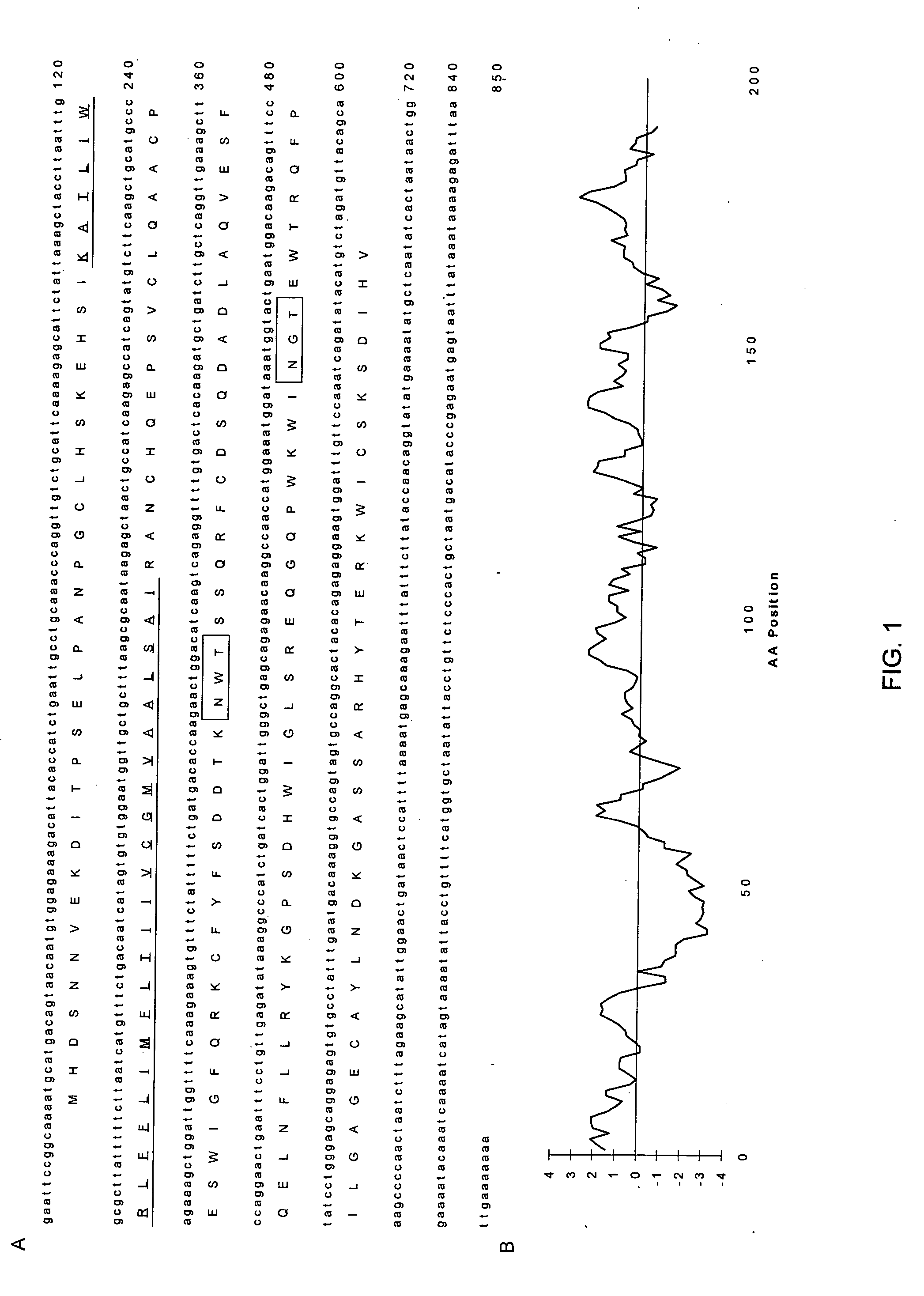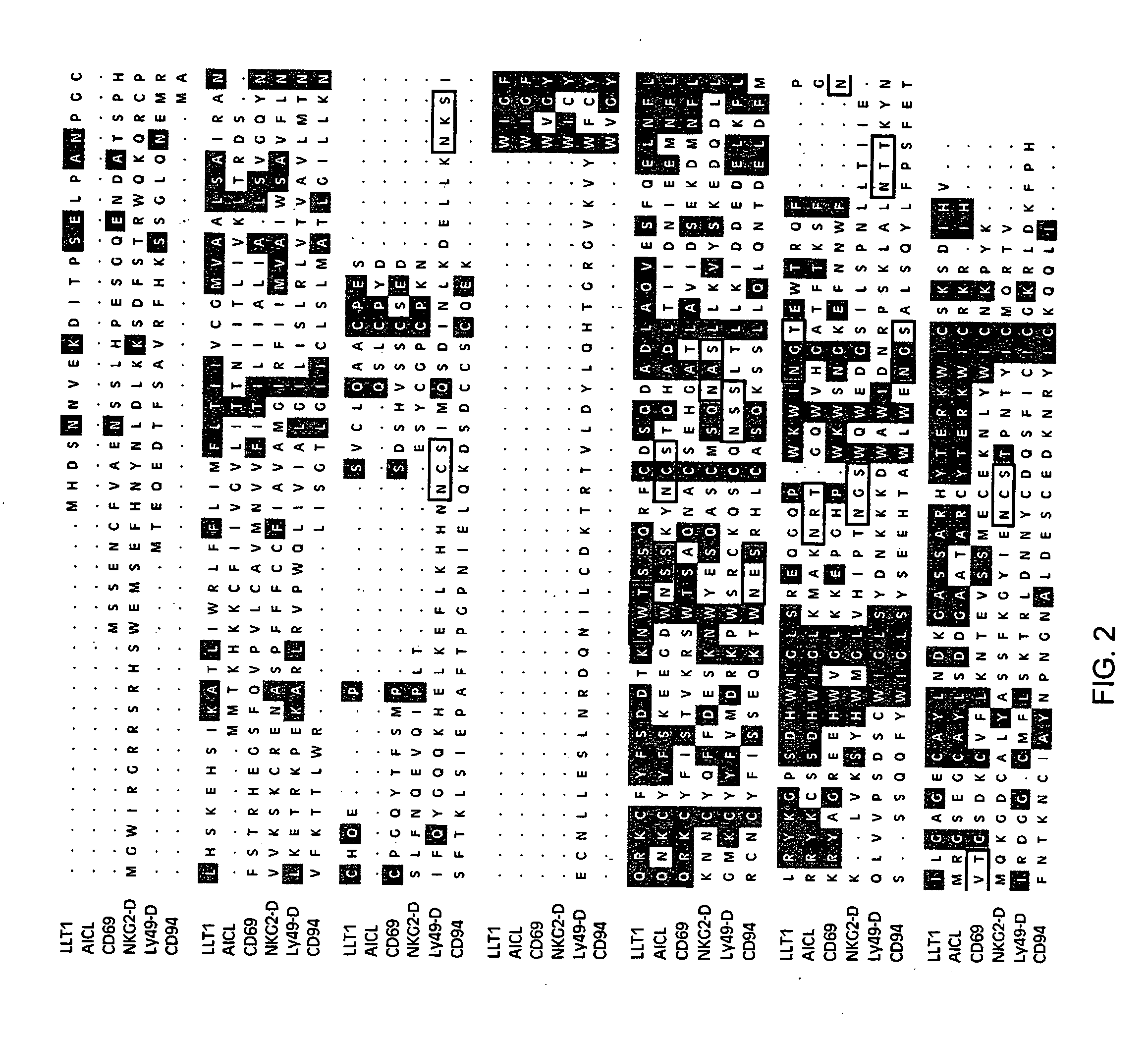LLT uses thereof in immune system modulation
a technology of immune system and receptor, applied in the field of specific cell surface receptor, can solve the problems that significant immune rejection difficulties preclude the use, and all the function of nk cells cannot be accounted for by known receptors, so as to reduce the natural killer cell mediated rejection of bone-marrow graft
- Summary
- Abstract
- Description
- Claims
- Application Information
AI Technical Summary
Benefits of technology
Problems solved by technology
Method used
Image
Examples
example 1
Expressed Sequence Tag Database Search and cDNA Library Screening
[0057] The expressed sequence tag (EST) database at GenBank was searched with the TblastN program vs. a consensus sequence of human (CD69, CD94, and NKG2's) and mouse (Ly-49's) C-type lectin receptors (Boguski et al. 1993, 1995). Several overlapping clones were identified and polymerase chain reaction (PCR) primers were designed to amplify a 350 base pair (bp fragment within the C-type lectin CRD. CDNA from a NK cell library constructed in X phage by J. Houchins (R & D Systems, Minneapolis, Minn., and kindly provided by A. Brooks, NlH, Bethesda, Md.) was successfully used as template. PCR cycle conditions were 94° C. for 30 s, 50° C. annealing temperature for 30 s, and a 72° C. extension for 45 s repeated for 30 cycles using Taq DNA polymerase from GIBCO BRL (Grand Island, N.Y.) at 2 MM MgC12. The same library was then screened with the resulting PCR fragment labeled with a320 d / ct0 (Feinberg and Vogelstein 1983; Samb...
example 2
Cell Culture
[0058] Human tumor cell lines Jurkat (T cell), YT (NK cell), HL-60 (monocytic), and DB (B cell), in addition to a murine lymphoma cell line (YAC-1), were cultured in RPMI 1640 supplemented with 10% fetal calf serum (Hyclone, Logan, Utah), 2 MM L-glutamine, 100. Units / ml of penicillin and steptomycin, 1 mM sodium pyruvate, and 0.1 mM non-essential. amino acids (Gibco BRL). A lymphokine-activated killer cell (LAX) culture was obtained by isolating peripheral blood mononuclear cells (PBMC) from 60 ml of venous blood from a healthy donor by Ficol-Paque centrifuigation (Pharmacia, Pescataway, N.J.). The cells were grown in the above media supplemented with 1000 Units / ml of human rIL-2 for three days. The non-adherent cells were removed and the culture was continued in 500 Units / ml of human rIL-2 and conditioned media until day 10, when RNA was extracted. All cell lines were grown to one million per ml and split 1:2 24 h before RNA isolation.
example 3
[0059] Total RNA was isolated with the RNAstate 60 reagent according to the manufacturer's protocol (Teltest Inc., Friendswood, Tex.), divided into 20 ug aliquots, and stored in 70% EtOH at −80° C. until used. One percent agarose gels for northern analysis were stained with ethidium bromide after electrophoresis to insure equal loading by comparison of rRNA. Northern blots were probed with 25 ng of the full-length cDNA labeled with a 32P dCTP (Feinberg and Vogelstein 1983; Sambrook et al. 1989). The first blot consisted of 20 ug of total RNA from human monocytic, T, B, and NK cell lines (HL-60, Jurkat, DB, and YT, respectively), a mouse cell line (YAC-1), and LAC and PBMC cells from a healthy donor immobilized on Hybond nylon (Amersham, Arlington Heights, Ill.). Prehybridization and hybridizations were performed according to the instructions of Amersham for the Hybond nylon membrane at 65° C. The second membrane was purchased from Clontech (Palo Alto, Calif...
PUM
| Property | Measurement | Unit |
|---|---|---|
| Cytotoxicity | aaaaa | aaaaa |
Abstract
Description
Claims
Application Information
 Login to View More
Login to View More - R&D
- Intellectual Property
- Life Sciences
- Materials
- Tech Scout
- Unparalleled Data Quality
- Higher Quality Content
- 60% Fewer Hallucinations
Browse by: Latest US Patents, China's latest patents, Technical Efficacy Thesaurus, Application Domain, Technology Topic, Popular Technical Reports.
© 2025 PatSnap. All rights reserved.Legal|Privacy policy|Modern Slavery Act Transparency Statement|Sitemap|About US| Contact US: help@patsnap.com



